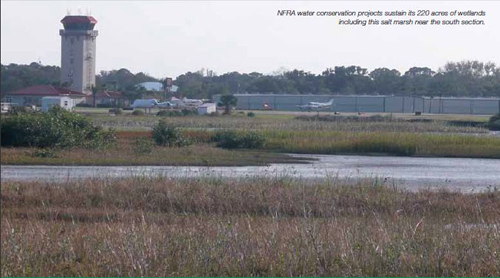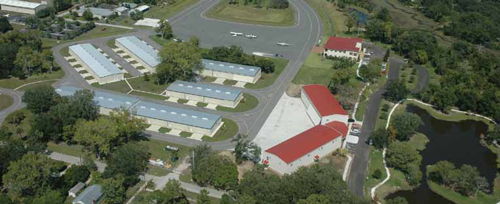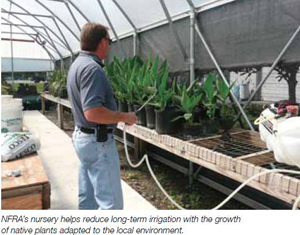NE Florida Regional Lands First FAA Funding for Sustainability Management Plan


Situated near the Atlantic shoreline, Northeast Florida Regional Airport (NFRA) in St. Augustine has proactively implemented environmental sustainability initiatives to protect its natural resources for years. By expanding its scope to include vital operations benchmarks, officials believe that a com prehensive sustainability plan will translate to strategic long-term organizational success.
With a staff of 11, airport management has demonstrated leadership through water conservation projects and measures to sustain NFRA's 220 acres of wetlands. New and existing economic, ecological and social initiatives affect the airport's approach to sustaining its assets.
|
factsfigures Project: Sustainability Management Plan Airport: Northeast Florida Regional Airport (NFRA) in St. Augustine Airport Owner: St. Augustine-St. John's County Airport Authority Airport Size: Approximately 750 acres Plan Cost: $230,000 Funding: 95% federal, 5% local airport authority Aviation Consultant: The LPA Group Sustainability Planning Consultant: Vanasse Hangen Brustlin Air Quality & Greenhouse Gas Consultant: KB Environmental Sciences Benefits: Economic growth, community relations, education partnering, energy efficiencies, waste reduction, natural resource conservation, water quality & cost savings. |

Sustainability planning consultant Vanasse Hangen Brustlin (VHB) reports that NFRA's pre-pilot plan cost $230,000 - with AIP funds covering fully 95% of the cost. St. Augustine-St. John's County Airport Authority funded the remaining $11,500. "By highlighting their recent environmental stewardship activities, we demonstrated to the FAA that this was an airport that would not do the plan and let it sit on the shelf. It was a good convergence," explains Ben Siwinski, VHB senior airport planner/project manager.
Holistic Approach
At the beginning of the 18-month study and planning process, NFRA administrators collaborated with VHB, KB Environmental Sciences and the airport's on-call aviation consultant, The LPA Group, to establish a sustainability vision, goals and objectives. The team also formed strategies for implementing and managing the initiatives, and produced performance measurement and reporting tools to ensure continual improvement toward sustainability goals.
Siwinski was pleased that a general aviation airport is serving as one of the models for the stand-alone program, because it will offer insight into the unique challenges of addressing sustainability with limited staff and financial resources. "First and foremost, the FAA wants to develop guidance for airports and best practices for good sustainability planning," Siwinski notes. "A GA airport has a much wider audience to learn best practices."
NFRA's Sustainability Management Plan was divided into two phases. During the first phase, the team conducted a baseline assessment to document the airport's current resource consumption and determine the current status of its sustainability and environmental initiatives. The second phase involved setting performance targets, developing an implementation plan and monitoring program and performance reporting.
 While traditional master plans typically include the environmental impact of accommodating an airport's forecasted demand, expanding the plan's scope to include sustainability goals significantly widens the conventional mindset. NFRA assistant airport manager, Bryan Cooper, likens the more holistic approach to a stool supported by four legs: economic viability, operational efficiency, conservation of natural resources and social responsibility.
While traditional master plans typically include the environmental impact of accommodating an airport's forecasted demand, expanding the plan's scope to include sustainability goals significantly widens the conventional mindset. NFRA assistant airport manager, Bryan Cooper, likens the more holistic approach to a stool supported by four legs: economic viability, operational efficiency, conservation of natural resources and social responsibility.
"Airport managers have always considered economic vitality and operational efficiency, and for 15 years we've had to look at environmental issues," relates Cooper. "What you're seeing now is all the legs of the stool are of equal length and importance."

Within the four primary objectives, the planning team identified nine operational categories and developed specific goals and strategies for each:
Economic Vitality
Community Relations
Planned Development
Energy
Air Quality
Natural Resources Management
Water Quality and Conservation
Materials and Waste Management
Airport Connectivity
 The scope of work was developed in close coordination with FAA's Planning and Environmental Division in Washington, D.C., notes Patrick Magnotta, environmental specialist with the FAA Office of Airport Planning and Programming. "The FAA is currently looking at how existing and future policies can best support sustainability initiatives at airports," Magnotta says. In the future, FAA's Office of Airports will continue to work with airports and industry groups to promote sustainability initiatives and research, he adds.
The scope of work was developed in close coordination with FAA's Planning and Environmental Division in Washington, D.C., notes Patrick Magnotta, environmental specialist with the FAA Office of Airport Planning and Programming. "The FAA is currently looking at how existing and future policies can best support sustainability initiatives at airports," Magnotta says. In the future, FAA's Office of Airports will continue to work with airports and industry groups to promote sustainability initiatives and research, he adds.
The Transportation Research Board's Airport Cooperative Research Program (ACRP) recently released Report 42: Sustainable Airport Construction Practices. Two more projects are underway (02-28 and 02-30) that focus on making it easier for airports to implement sustainability initiatives. "Once the initiatives and research are ripe for implementation, FAA will set policies and establish goals that ensure airports have the tools they need to become more sustainable," says Magnotta.
Economic Vitality & Social Progress
Belying the perception that sustainability is strictly an environmental issue, economic vitality took the highest priority at NFRA. And it's an objective Cooper anticipates could have the most profound effect on employees. "I saw it 25 years ago when the FAA and airports took a different tact on safety issues," he recalls. "There was a cultural change in airport employees. I think the same thing will happen with economic vitality."
As the planning process began in 2009, nearly $4.7 million in operating expenses were the highlight of NFRA's economic status. Operating and non-operating revenues had dipped slightly to $2.7 million and $6.8 million, respectively. The revenue drops precipitated a nine percent increase in lease revenue to $2.1 million. To enhance aeronautical and non-aeronautical revenue and facilitate economic growth, NFRA is concentrating efforts on encouraging private sector investment, facilitating trade and tourism, setting lease rates to drive return on investment, and working to become fully self-supporting.
The need for financial sustainability was reinforced before the plan was established, when the airport's ad valorem tax was discontinued and $3 million of its annual $14 million revenue was lost. With fewer fiscal resources, the identification of efficiencies, which comprises up to 25% of the airport's sustainability plan, assumed critical focus, explains Cooper.
"The real opportunity for savings will come in the way we look at capital improvements," he remarks. "We'll design and construct buildings that will operate much more efficiently than the ones we built five years ago. Our engineers and designers will receive a checklist of items for consideration such as green roofs, rainwater management and the orientation of windows for sunlight."

Positive community relations and educational outreach were top priorities that entail promoting the airport's role as a regional economic gateway, partnering with local college and high school aviation programs, providing airport tours, sponsoring non-aviation events and issuing press releases. The airport authority also operates two websites to communicate with airport users and the public, and has begun using social media outlets such as Facebook, Twitter and YouTube.
Best Practices
Including sustainability principles in the planning process casts them as core objectives rather than secondary considerations, note sustainability consultants. At NFRA, Cooper has been able to use the experience to create a road map for identifying ways to promote effective design, project implementation and financial best practices. "We've got to implement our plan before I can say what our best practices are, but I think planning is what will make the difference," he predicts. 
Airport officials are considering using a German "biomonitoring" process that involves testing honey produced in on-airport beehives to indicate air quality conditions. Collecting rainwater for landscaping maintenance is also being considered.
After months of study and planning, NFRA is nearly ready to begin implementing its Sustainability Management Plan. According to Cooper, it will be financed through annual budget allocations, capital improvement projects, grants, user fees and lease agreements with the airport's 26 commercial tenants.
The plan's second phase is being finalized with the creation of a prioritization matrix, which will help the airport authority and management identify initial projects - specifically short-term efforts involving small-scale capital improvements and low-cost essential maintenance activities with high potential return in five years. Longer-term initiatives associated with airport redevelopment may depend on future regional development. An implementation chart identifies the steps and personnel responsible for implementing each initiative, as well as target dates for completion.
 VHB provided monitoring and tracking spreadsheets for the airport to incorporate into an annual report card. "Those spreadsheets are tied to existing records for financial, energy and water use data," comments Siwinski. "They'll be able to efficiently evaluate their performance over time, and make any necessary adjustments to enhance their performance."
VHB provided monitoring and tracking spreadsheets for the airport to incorporate into an annual report card. "Those spreadsheets are tied to existing records for financial, energy and water use data," comments Siwinski. "They'll be able to efficiently evaluate their performance over time, and make any necessary adjustments to enhance their performance."
Siwinski expects sustainability planning to eventually become a common part of industrywide airport master planning - similar to the way FAA developed guidance to incorporate environmental evaluations into master plans. "The plan developed with St. Augustine is outside of the master planning process, but it provided the framework for the airport to consider sustainability in the everyday operation and the planning and design of airport construction projects," he explains. "It also provides the FAA some good lessons learned and some best practices to conduct sustainability planning at airports."
FREE Whitepaper
Fairbanks International Airport Baggage Transport Conveyor Enhanced With Mod Drive™ System
Airports face a host of unique industry challenges, such as meeting efficiency regulations and seeking out the best maintenance practices to reduce costs and keep operations flowing. In today’s current economic climate, any potential cost savings can go a long way.
In 2019, Alaska’s Fairbanks International Airport (FAI) sought to modernize its equipment and operations. They were dissatisfied with the performance of the gearmotors on their baggage transport conveyors and began searching for new suppliers. Regal approached FAI with a solution that could improve equipment performance and simplify maintenance, with the added benefit of energy cost savings: the Hub City® MOD Drive™ system.
This white paper discusses the hardware deployed, the test results and the annualized expectations for ROI.








